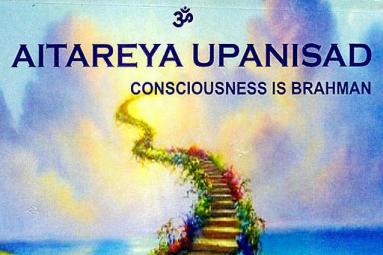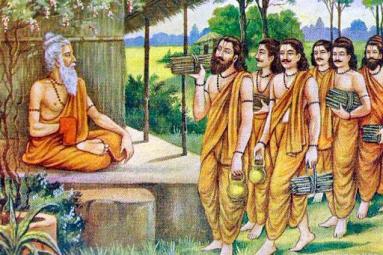
This is the secret of the knowledge of the Universal Being, designated as Vaishvanara. Its simple form of understanding is a transference of human attributes to the Divine Existence, and vice versa. In this meditation, one contemplates the Cosmos as one's body. Just as, for example, when one contemplates one's individual body, one simultaneously becomes conscious of the right eye, the left eye, the right hand, the left hand, the right leg, the left leg, the head, the heart, the stomach, and all the limbs of the body at one and the same time, and one does not regard the different limbs of the body as distinguished from one another in any manner, all limbs being only apparently different, but really connected to a single personality. So, in this meditation, the consciousness is to be transferred to the Universal Being. Instead of one contemplating oneself as the individual body, one contemplates oneself as the Universal Body. Instead of the right eye, there is the sun. Instead of the left eye, there is the moon. Instead of the feet there is the earth. Instead of the head, there is the heaven, and so on. The limbs of the Cosmic Person are identified with the cosmic elements, and vice versa, so that there is nothing in the Cosmos which does not form an organic part of the body of the Virat, or Vaishvanara. When you see the vast world before you, you behold a part of your own body. When you look at the sun, you behold your own eye. When you look above into the heavens, you are seeing your own head. When you see all people moving about, you behold the various parts of your own personality. The vast wind is your breath. All your actions are cosmic movements. Anything that moves, does so on account of your movement. Your breath is the Cosmic Vital Force. Your intelligence is the Cosmic Intelligence. Your existence is Cosmic Existence. Your happiness is Cosmic Bliss.
Creation does not consist merely of the few parts that are mentioned in the Upanishad, as limbs of the Vaishvanara, by way of illustration. There are many other things which may come to our minds when we contemplate. We can start our meditation with any set of forms that may occur to our minds. We may be sitting in our rooms, and the first things that attract our attention may be the objects spread out in the rooms. When we identify these objects with our body, we will find that there are also objects outside these rooms. And, likewise, we can slowly expand our consciousness to the whole earth, and, then, beyond the earth, to the solar and stellar regions, so that we reach as far as our minds can reach. Whatever our mind can think, becomes an object for the mind; and that object, again, should become a part of the meditator's body, cosmically. And, the moment the object that is conceived by the mind is identified with the Cosmic Body, the object ceases to agitate the mind any more, because that object is not any more outside; it becomes a part of the body of the meditator. When an object becomes a part of our own body, it no more annoys us because it is not an object at all. It is a subject. The object has become the Cosmic Subject, in the Vaishvanara meditation.
The vidya has its origin, actually, in the Rig-Veda, in a famous sukta, or hymn, called the Purusha-Sukta. The Purusha-Sukta of the Rig-Veda commences by saying that all the heads, all the eyes, and all the feet that we see in this world are the heads, eyes, and feet of the Virat-Purusha, or the Cosmic Being. With one head, the Virat nods in silence; with another face He smiles; with a third one He frowns; in one form, He sits; in another form, He moves; in one form, He is near; in another form, He is distant. So, all the forms, whatever they be, and all the movements and actions, processes and relations, become parts of the Cosmic Body, with which the Consciousness should be identified simultaneously. When you think, you think all things at the same time, in all the ten directions, nay, in every way.
The Chhandogya Upanishad concludes this vidya by saying that one who meditates in this manner on the Universal Personality of Oneself as the Vaishvanara, becomes the Source of sustenance for all beings. Just as children sit round their mother, hungry, and asking for food, all beings in creation shall sit round this Person, craving for his blessings; and just as food consumed by this body sustains all the limbs of the body at once, this meditator, if he consumes food, shall immediately communicate his blessings to the whole Cosmos, for his Being is, verily, All-Being.
We may recall to our memory the famous story of Sri Krishna taking a particle of food from the hands of Draupadi, in the Kamyaka forest, when she called to Him for help, and with this little grain that He partook of, the whole universe was filled, and all people were satisfied, because Krishna stood there tuned up with the Universal Virat. So is also the case with any person who is in a position to meditate on the Virat, and assumes the position of the Virat. The whole Universe shall become friendly with this Person; all existence shall ask for sustenance and blessing from this Universal Being. This meditator is no more a human being; he is, veritably, God Himself. The meditator on Vaishvanara is in communion with the universe, with the very Self of all beings, attuned to the Supreme Being.
A question arises here: how could all creation be satisfied if just one person takes food? This is not possible unless there is only one Self everywhere. If my self and your self and the self of different persons and things are different, one from the other, it is not possible that the satisfaction of one self can be the satisfaction of another self. If there can be a single satisfaction for the whole universe, there should be only one Self in the whole universe, not many selves, 'I', 'you', 'he', etc. Is it true, there is only one Self in the whole universe or are there many selves? How are we to understand this doctrine that there is only a single Self, and whoever is attuned to this single Self is the Self of all? So, whatever that person does is the action of everybody. But, how are we to make out this truth that there is only one Self? To elucidate this point the next chapter is taken up which goes further into the subject of the Vaishvanara Himself, and analyses in detail the constituents of the universe and the individual, expatiates the fact that there cannot be many realities, many subjects, or many selves. There is one Self. Everywhere, wherever you go, whatever you touch is an encounter of yours in respect of a single Reality. Whatever the experience, you are travelling within the body of that single Self. Anything that you do is known to that Self; it has connection with that Self, so that every Self is one's self. Towards this subject the sixth chapter of the Upanishad is carried, and the chapter commences with an anecdote, a story, an occurrence, a description of a conversation between father and son, Uddalaka Aruni and his student, his son, Svetaketu.
Source: http://upanishads.jnanajyoti.com







